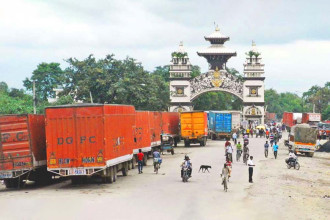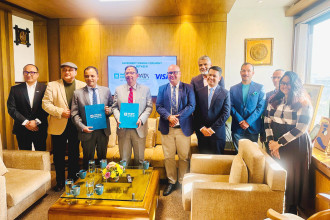
-
Stakeholders predict enhanced supply chains and investment inflows once operations commence
KANCHANPUR: For local resident Uttar Bhatta of Dodhara Chandani area in Mahakali Municipality-1 in Kanchanpur District, the announcement that a dry port will be built in Dodhara Chandani — news he first heard about around 15 years ago — now feels like a dream.
He had never imagined that a bridge would be built over Mahakali River or that a dry port would be constructed. Previously, he had to use an Indian road just to travel to and from Mahendranagar. “We had to take a small boat across Mahakali to get to Mahendranagar. If someone got sick, medical treatment was a problem as there was no road for an ambulance to come,” Bhatta said. “Now, a six-lane paved road reaches right in front of my house, and construction of a dry port has started nearby. It feels like a dream to me.”
Bhatta, who has lived there since 1965, said that after enduring many hardships, the new bridge and road over Mahakali River have transformed Dodhara Chandani. “We had to use an Indian road to go to Mahendranagar, and Indian security personnel would harass us on various pretexts,” he added. “It had been more than a decade since leaders promised us a dry port, so we never thought this kind of development would happen.” He expects local products to find a market once the port is operational.
Dambar Dhami, another resident of Mahakali Municipality-1, whose son works in Bengaluru, India, hopes his son will secure employment locally after the port opens. “Once the port is built, even if I set up a shop at home, it will do well; there will be no need to go to India,” he said. “The movement of people has also increased here.” He noted that land values have risen since the bridge and six-lane access road were built: plots that used to sell for Rs 100,000– Rs 200,000 now fetch up to Rs 7 million.
Since the government’s 2007 announcement to build a dry port in Dodhara Chandani, local businesspeople have dreamed of a trilateral border point opening trade with third countries. They received confirmation this year that the project would proceed after 18 years. Rudrapur, a neighbouring industrial area in India, is Nepal’s closest major manufacturing hub at 90 kilometres away — a two-hour drive — but Sudurpashchim Province has been unable to trade there until now.
“We have been forced to import goods from India’s largest industrial area by travelling an extra 300 kilometres, which results in expensive transport costs,” said Jang Bahadur Malla, a central member of the Federation of Nepalese Chambers of Commerce and Industry (FNCCI). “The port’s construction will greatly help to achieve economic prosperity not only for Sudurpashchim but for the entire country.” He explained that imports and exports to Rudrapur currently use the Rupiadiya, Bhairahawa and Birgunj checkpoints. “Sudurpashchim has a lot of potential, including herbs. After the port is built, it will be easier to trade with third countries as well,” he added. “This will not only reduce the cost of goods but also open up employment opportunities.” He said easy access to New Delhi and Rudrapur in Uttarakhand will greatly contribute to the region’s development.
Although the dry port was announced in 2007, procedural complications delayed its construction. Ashish Gajurel, executive director of the Nepal Intermodal Transport Development Board, said preliminary work has now commenced. “The initial construction work has started. In the first phase, we will carry out land-filling, build walls and bring in the necessary materials,” he said. “It will be formally inaugurated by the prime ministers of both countries.” He added that the project will boost economic development across Sudurpashchim and Nepal as a whole.
“This trade infrastructure should not just serve to import from India but also to establish industries for export,” he said. “There is a great opportunity to export to third countries through this border point, so we should also focus on production for export.” The port’s infrastructure is being erected on 42.36 hectares of land in the Gaurishankar Community Forest in Dodhara Chandani Municipality 1.
A memorandum of understanding for the dry port, to be built with financial and technical assistance from the Government of India, was signed by Nepal and India on 1 June 2023. Under that agreement, the Indian side awarded a contract for the port’s construction at a cost of INR 2,543.19 million.
The Intermodal Transport Development Board said the 42.36 hectares will accommodate two warehouse buildings, a customs inspection building, a quarantine building, an immigration building and a security building.
Due to a lack of easy connectivity with India, Sudurpashchim has been unable to trade effectively. The Trinagar border point in Kailali has served merely as a transit route. Kanchanpur District is nearest to India’s largest industrial cities and other areas with significant economic activity.
While the western border point will open many possibilities in Sudurpashchim once operational, Nepal must prepare, according to economic analyst and FNCCI Director General Gorkarna Raj Awasthi. “Once this border point becomes operational, the compulsion to travel long distances will be eliminated,” he said. “If the government can develop industries and agriculture in Sudurpashchim before full operation, it will find a market in India’s northern provinces and Uttarakhand.” Nepal has already operationalised the six-lane access road to the dry port and the four-lane bridge over Mahakali River.
By RSS



-1764159674.jpg)


